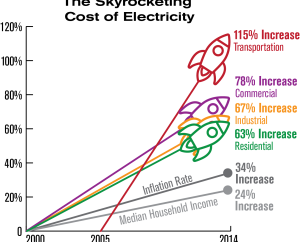When light gleams on a photovoltaic (PV) cell – likewise called a solar cell – that light might be reflected, consumed, or go directly through the cell. The PV cell is composed of semiconductor material; the “semi” implies that it can conduct power better compared to a protector but not as well as a decent conductor like a metal- Houston Energy Plans . There are a few different semiconductor materials utilized in PV cells.
When the semiconductor is presented to light, it assimilates the light’s energy and moves it to adversely charged particles in the material called electrons. This additional energy permits the electrons to move through the material as an electrical current. This current is extricated through conductive metal contacts – the network-like lines on solar cells – and can then be utilized to power your home and the remainder of the electric framework.

The proficiency of a PV cell is basically how much electrical power comes out of the cell compared to the energy from the light gleaming on it, which shows how viable the cell is at converting energy from one structure to the next. How much power is delivered from PV cells relies upon the qualities (like force and frequencies) of the light accessible and various exhibitions ascribes to the cell?
A significant property of PV semiconductors is the bandgap, which shows what frequencies of light the material can ingest and convert to electrical energy. Assuming the semiconductor’s bandgap matches the frequencies of light radiating on the PV cell, then that cell can effectively utilize all the accessible energy.
Learn more underneath about the most commonly-involved semiconductor materials for PV cells.
An image of three solar cells made from various silicon materials: thin-film, monocrystalline, and polycrystalline silicon.
Silicon
Silicon is, by a long shot, the most common semiconductor material utilized in solar cells, addressing roughly 95% of the modules sold today. It is likewise the second most bountiful material on The planet (after oxygen) and the most common semiconductor utilized in computer chips. Glass-like silicon cells are made of silicon iotas connected to frame a gem grid. This grid gives a coordinated construction that makes the conversion of light into power more proficient.
Solar cells made from silicon currently give a combination of high effectiveness, minimal expense, and a long lifetime. Modules are supposed to keep going for quite a long time or more, actually delivering over 80% of their unique power after this time.
Thin film photovoltaics
A thin-film solar cell is made by storing at least one thin layer of PV material on a supporting material like glass, plastic, or metal. There are two primary kinds of thin-film PV semiconductors available today: cadmium telluride (CdTe) and copper indium gallium diselenide (CIGS). The two materials can be kept straightforwardly onto either the front or back of the module surface.
CdTe is the second-most common PV material after silicon, and CdTe cells can be made utilizing minimal expense-producing processes. While this makes them a cost-powerful other option, their efficiencies aren’t exactly pretty much as high as silicon. CIGS cells have ideal properties for a PV material and high efficiencies in the lab, yet the complexity engaged with combining four components makes the change from lab to assembling seriously testing. Both CdTe and CIGS require more insurance than silicon to empower enduring activity outside.
Perovskite Photovoltaics
Perovskite solar cells are a sort of thin-film cell and are named after their trademark precious stone design. Perovskite cells are worked with layers of materials that are printed, coated, or vacuum-stored onto a basic help layer, known as the substrate. They are normally simple to collect and can arrive at efficiencies like glass-like silicon. In the lab, perovskite solar cell efficiencies have worked quicker than some other PV material, from 3% in 2009 to more than 25% in 2020. To be commercially practical, perovskite PV cells need to become steady to the point of enduring 20 years outside, so scientists are chipping away at making them more sturdy and growing enormous scope, minimal expense producing strategies.




